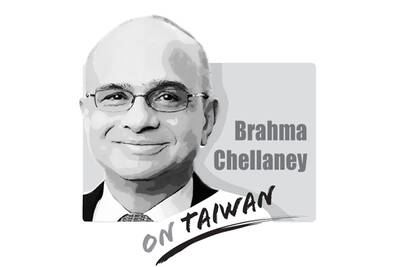The Chinese Nationalist Party (KMT) has a good reason to avoid a split vote against the Democratic Progressive Party (DPP) in next month’s presidential election. It has been here before and last time things did not go well.
Taiwan had its second direct presidential election in 2000 and the nation’s first ever transition of political power, with the KMT in opposition for the first time.
Former president Chen Shui-bian (陳水扁) was ushered in with less than 40 percent of the vote, only marginally ahead of James Soong (宋楚瑜), the candidate of the then-newly formed People First Party (PFP), who got almost 37 percent. The KMT’s candidate, former premier Lien Chan (連戰), was third with just over 23 percent.
Soong’s supporters could arguably say that he was robbed, as he would have won had it not been for Lien’s campaign.
Taiwan’s presidential elections operate on a universal direct suffrage system in which the president is elected by a simple majority, which is why Chen won in 2000. This year, the KMT and Taiwan People’s Party (TPP) Chairman Ko Wen-je (柯文哲) attempted to form a joint ticket for the Jan. 13 election. While it failed, a post-election coalition would enable the TPP and the KMT to hamstring a DPP president in the legislature if they secured enough seats, as happened when the PFP and the KMT worked together to block Chen’s legislative minority government from 2000 to 2008.
It looks likely that this is exactly what could transpire: Even if Vice President William Lai (賴清德) wins for the DPP, he could face an aligned KMT-TPP opposition that possesses between them a legislative majority.
Coalition governments are common in other countries. As a political solution, the formula has its champions, just as it has its detractors. Essentially, the political situation and the electoral system of the country determine whether a coalition is warranted.
Even the UK had a rare experiment with a coalition government in 2015, when the Conservative Party joined forces with the Liberal Democrats to secure a parliamentary majority against the Labour Party. As with most coalition governments, the horse-trading commenced only after the election results were announced, when the Conservatives found that they needed a smaller party to add to their seats in parliament.
There are positive aspects to coalition governments, especially in deeply polarized political environments. Ideological partisanship among the electorate can potentially be softened when parties work together.
The KMT and the TPP have differing platforms, and historical baggage from those platforms, but they are not as diverse as, for example, the KMT and the DPP.
A KMT-TTP coalition could work in principle. Unfortunately, any cooperation between them will be first and foremost characterized by power relations, antipathy, mutual suspicion and ideology.
The parties are certainly not natural partners, and the only thing that binds them together — antipathy to the DPP — would dissipate the second they won.
Moreover, their advantage in the legislature would still emerge had neither party tried the alliance plan, which has prompted an investigation that they contravened the Presidential and Vice Presidential Election and Recall Act (總統副總統選舉罷免法), an action brought by Taipei Republic Office director Chilly Chen (陳峻涵) and attorney Huang Di-ying (黃帝穎).
Soong’s participation in the 2000 race was the result of strategic missteps by the KMT leadership of the time. Their successors fear that next month will be a repeat of its strategic blunder of two decades ago.

As strategic tensions escalate across the vast Indo-Pacific region, Taiwan has emerged as more than a potential flashpoint. It is the fulcrum upon which the credibility of the evolving American-led strategy of integrated deterrence now rests. How the US and regional powers like Japan respond to Taiwan’s defense, and how credible the deterrent against Chinese aggression proves to be, will profoundly shape the Indo-Pacific security architecture for years to come. A successful defense of Taiwan through strengthened deterrence in the Indo-Pacific would enhance the credibility of the US-led alliance system and underpin America’s global preeminence, while a failure of integrated deterrence would
US President Donald Trump created some consternation in Taiwan last week when he told a news conference that a successful trade deal with China would help with “unification.” Although the People’s Republic of China has never ruled Taiwan, Trump’s language struck a raw nerve in Taiwan given his open siding with Russian President Vladimir Putin’s aggression seeking to “reunify” Ukraine and Russia. On earlier occasions, Trump has criticized Taiwan for “stealing” the US’ chip industry and for relying too much on the US for defense, ominously presaging a weakening of US support for Taiwan. However, further examination of Trump’s remarks in
It is being said every second day: The ongoing recall campaign in Taiwan — where citizens are trying to collect enough signatures to trigger re-elections for a number of Chinese Nationalist Party (KMT) legislators — is orchestrated by the Democratic Progressive Party (DPP), or even President William Lai (賴清德) himself. The KMT makes the claim, and foreign media and analysts repeat it. However, they never show any proof — because there is not any. It is alarming how easily academics, journalists and experts toss around claims that amount to accusing a democratic government of conspiracy — without a shred of evidence. These
China on May 23, 1951, imposed the so-called “17-Point Agreement” to formally annex Tibet. In March, China in its 18th White Paper misleadingly said it laid “firm foundations for the region’s human rights cause.” The agreement is invalid in international law, because it was signed under threat. Ngapo Ngawang Jigme, head of the Tibetan delegation sent to China for peace negotiations, was not authorized to sign the agreement on behalf of the Tibetan government and the delegation was made to sign it under duress. After seven decades, Tibet remains intact and there is global outpouring of sympathy for Tibetans. This realization